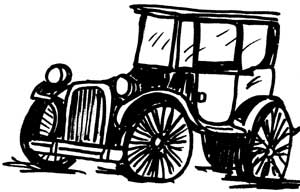
Deciding which classic car to purchase may seem straightforward. Just pick your favorite model and go for it. However, practical considerations like budget, availability of parts, and long-term restoration goals often complicate the process. By answering the questions outlined in this chapter, you can narrow your options and set realistic expectations.
1. Establish Your Budget
The first and most critical step is determining how much you can afford. Sit down with anyone who shares your finances (e.g., a spouse or partner) to outline a sensible spending limit. This includes not just the purchase price but also costs for insurance, storage, maintenance, and potential restorations. You may love the idea of a rare Duesenberg or Yenko, but the reality might be out of reach if your budget is modest.
2. Research Models Within Your Price Range
After settling on a budget, use the resources detailed in Chapters 2 - 6 to research potential models. Online listings, classic car magazines, and community forums are excellent places to start. If you’re new to classic car ownership, consider buying a drivable vehicle in decent condition. While it may not be “perfect,” you can still enjoy the car right away and learn about its upkeep gradually, without sinking into an unfinished project that might sit idle for years.
3. Consider Parts Availability
Rare models or those with limited production runs can be more challenging and expensive to source parts for. A car that’s almost within your budget might cost much more in the long run if parts are scarce or prohibitively expensive. Verify parts availability online, through local restoration shops, or via enthusiasts’ clubs. Popular models (e.g., Ford Mustangs, Chevrolet Camaros) generally have plenty of aftermarket parts, making ownership more manageable.
4. Numbers Matching vs. “Mutts”
“Numbers matching” refers to a car retaining its original factory drivetrain (engine, transmission, etc.). These cars often command higher resale values. If you plan to restore a non-running vehicle missing its original drivetrain, understand that you’re essentially creating a “mutt.” Restoring it back to full originality will be extremely difficult, if not impossible if that's what your aim is. If future resale value matters, aim for a numbers-matching example if it is in your budget and available.
5. Assess Potential Value & Demand
Before committing to a car (especially if you plan on a full restoration), research the market value of that model once restored. A vehicle can be rare but not necessarily valuable if collectors aren’t interested in it. Don’t fall into the trap of spending $50,000 to restore a car that will only be worth $20,000 afterward, unless you’re doing it purely for personal passion and not worried about recouping costs. I've heard so many stories of owners thinking because they sunk X amount into the car, that cost ads to the value. Not at all true, it all depends on the market AND if a potential buyer feels the added cost is worth the price.
6. Understand Different Condition Categories
Classic cars can be loosely grouped into several condition categories, each with its own pros and cons:
Non-Running “Project” Cars
- Pros: Often inexpensive initial purchase price, can be a dream project if you have the time, budget, and skills.
- Cons: May require substantial work. Rust repair, engine rebuilds, bodywork. Many projects are never finished, especially for first-time buyers. Abandoned restorations can be a nightmare for potential buyers due to missing/lost parts, vehicle already taken apart and will not be put back together by the same person, etc. Most abandoned restorations I see are sold as fractions of what the car is truly worth, because of the hassls the new owner will face.
Running Cars in Need of Restoration
- Pros: You can enjoy driving your classic while gradually improving it. Many classic cars on the market fit this category.
- Cons: Rust is a major concern; hidden corrosion can lead to expensive surprises. Always check carefully, as a small patch of rust could indicate more extensive damage.
Fully Restored & Concours Cars
- Pros: Highest quality, often show-ready. No immediate restoration work needed.
- Cons: These vehicles can be extremely expensive. Many “trailer queens” are rarely driven due to their pristine condition, which may lessen your overall enjoyment if you actually want to cruise the car.
Clones or “Tribute” Cars
- Pros: You can enjoy the look and feel of a rare model (e.g., a Yenko Chevelle or Shelby Mustang) at a lower price. Often built with upgraded performance parts.
- Cons: No matter how well done, a clone doesn’t command the same resale value as a numbers-matching original. Disclosure of clone status is essential for ethical reasons, but shouldn't take a lot of research to find they are not true models when looking at the engine and transmission codes, etc..
Unrestored Originals
- Pros: A growing niche; some collectors prize the authenticity of factory paint and parts, including minor imperfections. A true “survivor” can be a thrilling discovery.
- Cons: These cars may have hidden mechanical or cosmetic issues. Original parts can be expensive or difficult to replace if something breaks.
Chapter 1 Conclusion
Selecting the right classic starts with understanding your budget, the model’s potential value, and parts availability. Chapters 2 - 6 will detail how to research prices effectively and connect with model-specific communities. Immerse yourself in forums, car clubs, and shows to gather real-world experiences from current and former owners. Also, brush up on factory codes, VINs, and other identifying marks so you can verify claims about numbers matching or limited-edition models.
Once you’ve pinpointed a model or short list of possibilities, you’ll be ready to take the next step. Actual inspection and negotiation. By starting with the right foundation in Chapter 1, you’ll maximize your chances of finding the perfect classic car for both your budget and your dreams.

 Complete Classic Car Buyer's Guide
Complete Classic Car Buyer's Guide